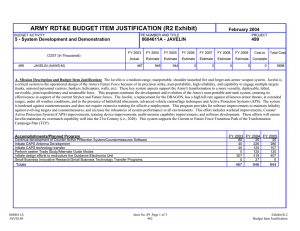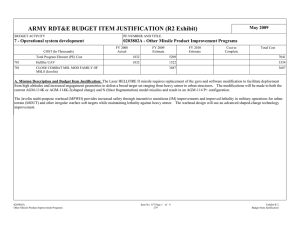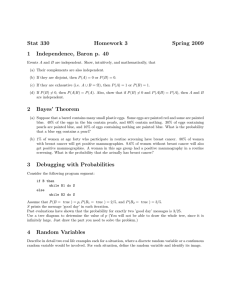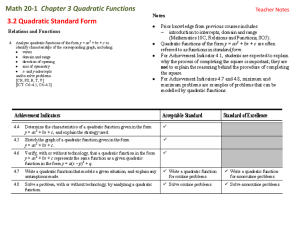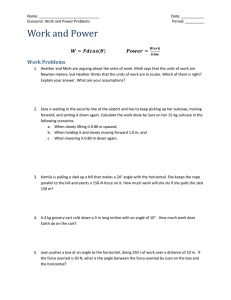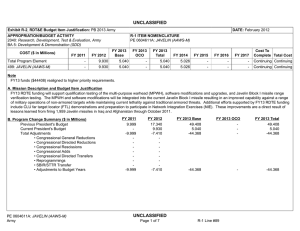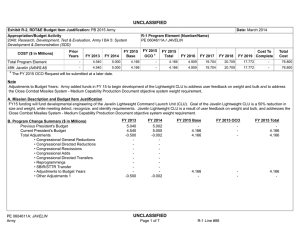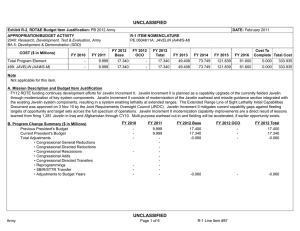Javelin Close Combat Missile System – Medium
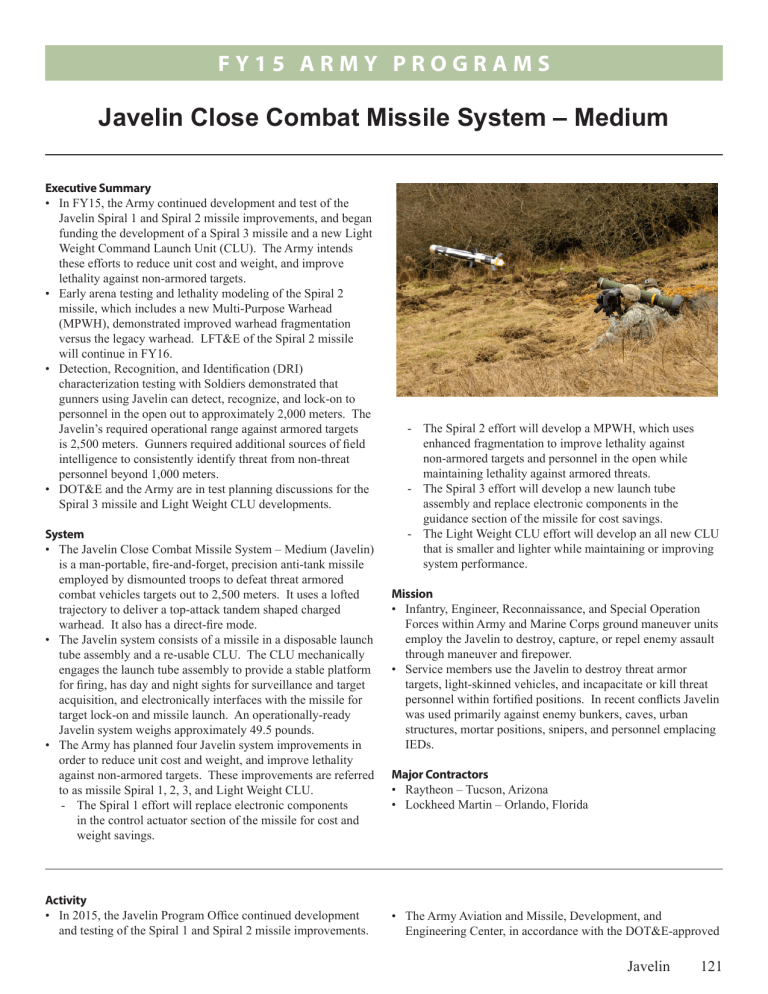
F Y 1 5 A R M Y P R O G R A M S
Javelin Close Combat Missile System – Medium
Executive Summary
• In FY15, the Army continued development and test of the
Javelin Spiral 1 and Spiral 2 missile improvements, and began funding the development of a Spiral 3 missile and a new Light
Weight Command Launch Unit (CLU). The Army intends these efforts to reduce unit cost and weight, and improve lethality against non-armored targets.
• Early arena testing and lethality modeling of the Spiral 2 missile, which includes a new Multi-Purpose Warhead
(MPWH), demonstrated improved warhead fragmentation versus the legacy warhead. LFT&E of the Spiral 2 missile will continue in FY16.
• Detection, Recognition, and Identification (DRI) characterization testing with Soldiers demonstrated that gunners using Javelin can detect, recognize, and lock-on to personnel in the open out to approximately 2,000 meters. The
Javelin’s required operational range against armored targets is 2,500 meters. Gunners required additional sources of field intelligence to consistently identify threat from non-threat personnel beyond 1,000 meters.
• DOT&E and the Army are in test planning discussions for the
Spiral 3 missile and Light Weight CLU developments.
System
• The Javelin Close Combat Missile System – Medium (Javelin) is a man-portable, fire-and-forget, precision anti-tank missile employed by dismounted troops to defeat threat armored combat vehicles targets out to 2,500 meters. It uses a lofted trajectory to deliver a top-attack tandem shaped charged warhead. It also has a direct-fire mode.
• The Javelin system consists of a missile in a disposable launch tube assembly and a re-usable CLU. The CLU mechanically engages the launch tube assembly to provide a stable platform for firing, has day and night sights for surveillance and target acquisition, and electronically interfaces with the missile for target lock-on and missile launch. An operationally-ready
Javelin system weighs approximately 49.5 pounds.
• The Army has planned four Javelin system improvements in order to reduce unit cost and weight, and improve lethality against non-armored targets. These improvements are referred to as missile Spiral 1, 2, 3, and Light Weight CLU.
- The Spiral 1 effort will replace electronic components in the control actuator section of the missile for cost and weight savings.
The Spiral 2 effort will develop a MPWH, which uses enhanced fragmentation to improve lethality against non-armored targets and personnel in the open while maintaining lethality against armored threats.
- The Spiral 3 effort will develop a new launch tube assembly and replace electronic components in the guidance section of the missile for cost savings.
- The Light Weight CLU effort will develop an all new CLU that is smaller and lighter while maintaining or improving system performance.
Mission
• Infantry, Engineer, Reconnaissance, and Special Operation
Forces within Army and Marine Corps ground maneuver units employ the Javelin to destroy, capture, or repel enemy assault through maneuver and firepower.
• Service members use the Javelin to destroy threat armor targets, light-skinned vehicles, and incapacitate or kill threat personnel within fortified positions. In recent conflicts Javelin was used primarily against enemy bunkers, caves, urban structures, mortar positions, snipers, and personnel emplacing
IEDs.
Major Contractors
• Raytheon – Tucson, Arizona
• Lockheed Martin – Orlando, Florida
Activity
• In 2015, the Javelin Program Office continued development and testing of the Spiral 1 and Spiral 2 missile improvements.
• The Army Aviation and Missile, Development, and
Engineering Center, in accordance with the DOT&E-approved
Javelin 121
F Y 1 5 A R M Y P R O G R A M S live fire strategy, conducted live fire arena tests of the MPWH to characterize missile and warhead fragmentation. Static and dynamic testing, and live warhead end-to-end firings against a range of targets will continue in FY16.
• The Javelin Program Office conducted two DRI tests with
Soldiers in order to characterize the ability of gunners using only Javelin to detect, recognize, identify, and lock-on to secondary targets (IED team, mortar team, truck mounted machine gun) at various ranges in both daylight and night conditions. Tests were performed in February and July 2015, to capture both cold and hot ambient surroundings.
• DOT&E and the Army are in test planning discussions for the
Spiral 3 missile and Light Weight CLU.
Assessment
• The preliminary results of available live fire data indicate the
MPWH exhibits improved warhead fragmentation versus the legacy warhead. A comprehensive LFT&E program including static and dynamic testing, and end-to-end firings against a variety of targets is planned for FY16 to verify the MPWH performance prior to the production build beginning in FY17.
• Findings from the Javelin DRI characterization test include:
- Military gunners using the day and night sights of the
Javelin CLU without other field intelligence sources
(binoculars, UAV feed, etc.), can detect and recognize personnel in the open, but cannot identify threat personnel from non-threat personnel throughout the operational range and environment.
Military gunners were able to maintain target acquisition throughout the process of readying the Javelin to fire upon secondary targets identified as threats.
- Military gunners were able to maintain lock-on to individuals and small groups out to approximately
2,000 meters. Maintaining lock-on became more difficult due to the small signature presented by human sized targets beyond 2,000 meters.
Recommendations
• Status of Previous Recommendations. This is the first annual report for this program.
• FY15 Recommendation.
1. The Army should conduct an operational test before fielding Spiral 3 and/or Light Weight CLU to confirm that effectiveness and suitability has not been compromised, and compatibility with all fielded variants of the missile.
122 Javelin
